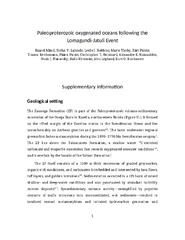Blar i forfatter Fakultet for naturvitenskap og teknologi "Paiste, Päärn"
-
Chromium evidence for protracted oxygenation during the Paleoproterozoic
Mänd, Kaarel; Planavsky, Noah J.; Porter, Susannah M.; Robbins, Leslie J.; Wang, Changle; Kreitsmann, Timmu; Paiste, Kärt; Paiste, Päärn; Romashkin, Alexander E.; Deines, Yulia E.; Kirsimäe, Kalle; Lepland, Aivo; Konhauser, Kurt O. (Journal article; Tidsskriftartikkel; Peer reviewed, 2022-03-24)It has commonly been proposed that the development of complex life is tied to increases in atmospheric oxygenation. However, there is a conspicuous gap in time between the oxygenation of the atmosphere 2.4 billion years ago (Ga) and the first widely-accepted fossil evidence for complex eukaryotic cells . At present the gap could either represent poor sampling, poor preservation, and/or difficulties ... -
Heterogeneous REE + Y distribution in Early Paleozoic shelly phosphorites: Implications for enrichment mechanisms
Lumiste, Kaarel; Lang, Liisa; Paiste, Päärn; Lepland, Aivo; Kirsimäe, Kalle (Journal article; Tidsskriftartikkel; Peer reviewed, 2021-10-27)Sedimentary phosphorites are important carriers of Rare Earth Elements and Yttrium (REE + Y). Primary biogenic and sedimentary apatite contain very low amounts of REE + Y and enrichment of these elements occurs during diagenesis. Although the influence of post-depositional processes on REE + Y concentrations in sedimentary phosphorites is well established, the processes controlling the degree of ... -
Hydrothermal dedolomitisation of carbonate rocks of the Paleoproterozoic Zaonega Formation, NW Russia — Implications for the preservation of primary C isotope signals
Kreitsmann, Timmu; Külaviir, Marian; Lepland, Aivo; Paiste, Kärt; Paiste, Päärn; Prave, Anthony R.; Sepp, Holar; Romashkin, Alexander E; Rychanchik, Dmitry V.; Kirsimäe, Kalle (Journal article; Tidsskriftartikkel; Peer reviewed, 2019-03-03)The Paleoproterozoic Zaonega Formation in Karelia, NW Russia, has played a key role in understanding the environmental conditions postdating the Great Oxidation and Lomagundi-Jatuli Events. Its carbonate- and organic-rich rocks (shungite) define the postulated Shunga Event representing an accumulation of very organic-rich sediments at c. 2 Ga and are central in ideas about changing ocean-atmosphere ... -
Palaeoproterozoic oxygenated oceans following the Lomagundi–Jatuli Event
Mänd, Kaarel; Lalonde, Stefan V.; Robbins, Leslie J.; Thoby, Marie; Paiste, Kärt; Kreitsmann, Timmu; Paiste, Päärn; Reinhard, Christopher T.; Romashkin, Alexandr E.; Planavsky, Noah J.; Kirsimäe, Kalle; Lepland, Aivo; Konhauser, Kurt O. (Journal article; Tidsskriftartikkel; Peer reviewed, 2020-03-16)The approximately 2,220–2,060 million years old Lomagundi–Jatuli Event was the longest positive carbon isotope excursion in Earth history and is traditionally interpreted to reflect an increased organic carbon burial and a transient rise in atmospheric O<sub>2</sub>. However, it is widely held that O<sub>2</sub> levels collapsed for more than a billion years after this. Here we show that black shales ... -
REE+Y uptake and diagenesis in Recent sedimentary apatites
Lumiste, Kaarel; Mänd, Kaarel; Bailey, Juke; Paiste, Päärn; Lang, Liisa; Lepland, Aivo; Kirsimäe, Kalle (Journal article; Tidsskriftartikkel; Peer reviewed, 2019-07-30)Rare Earth Elements and Yttrium (REE+Y) distribution in authigenic phases are frequently used as proxies for reconstructing past seawater conditions. Sedimentary apatite precipitates near the sediment-water interface and is therefore capable of recording the REE+Y composition of the overlying water column. While the overprinting of primary REE+Y signal during late stage diagenesis is a widely known ...


 English
English norsk
norsk



